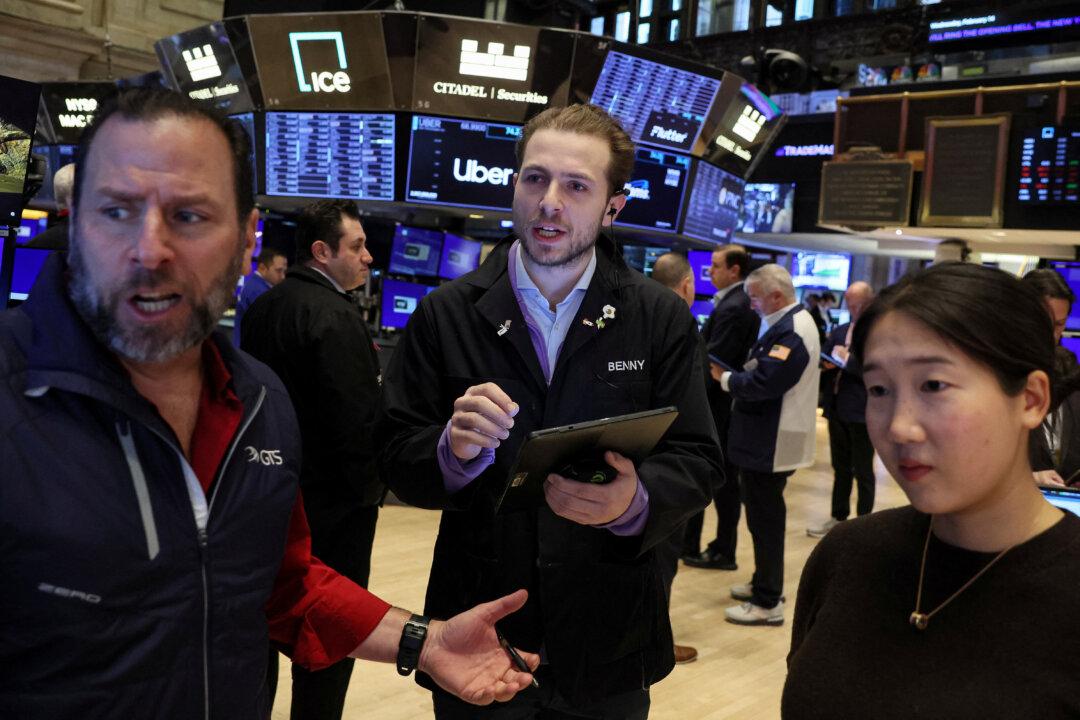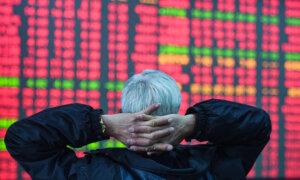Stocks are hovering in record territory, fueled by Nvidia Corp.’s monster earnings report following the Feb. 21 closing bell and investors pricing in the Federal Reserve cutting interest rates later this year.
The Dow Jones Industrial Average edged up 0.16 percent to 39,131. The benchmark S&P 500 Index tacked on 0.03 percent to 5,089. The tech-heavy Nasdaq Composite Index slipped 0.28 percent to 15,996.
The S&P 500 and the Dow Jones posted their largest weekly gains of the year, rallying around 1.7 percent and 1.3 percent, respectively. The Nasdaq Composite Index also recorded a weekly boost of 1.4 percent.
The Magnificent Seven
Goldman Sachs Research adjusted its year-end S&P 500 target higher, from 5,100 to 5,200, driven by the so-called “Magnificent Seven” stocks—Alphabet, Amazon, Apple, Meta Platforms, Microsoft, Nvidia, and Tesla—that have outperformed much of the rest of the players in the equities arena.“The Magnificent Seven is estimated to have lifted margins in the fourth quarter by 582 basis points (year over year), leading to earnings growth of 58 percent,” said David Kostin, the chief U.S. equity strategist at Goldman Sachs, in a note. “By contrast, margins for the remaining 493 stocks in the S&P 500 contracted by 56 basis points and earnings fell by 2 percent (the declines being driven primarily by energy stocks).”
Writing in a recent analyst note, Nancy Tengler, the CIO and CEO of Laffer Tengler Investments, thinks the “momentum could continue over the next several years.”
“All of these companies are benefiting and will continue to benefit from what we call the fourth industrial revolution (the rapid technological advancement being brought about by AI and supercomputing),” Ms. Tengler stated, adding that the rally will “broaden” beyond tech.
However, for now, a handful of companies are driving the stock market boom as hopes that the rally will widen have “dissipated like dust in the sky,” says Ipek Ozkardeskaya, the senior analyst at Swissquote Bank.
“Tech, and everything related to tech, is doing just fine. And the others surf on that optimism,” she noted.
According to The Kobeissi Letter, a popular financial newsletter on X, the Magnificent Seven is up 1,700 percent since 2015 compared to the S&P’s 140 percent gain.
“We now have a market that needs the Magnificent 7 stocks to push higher,” the firm wrote on X. “The Magnificent 7 stocks *are* the stock market.”
In addition, the top five stocks by market cap (Alphabet, Amazon, Apple, Microsoft, and Nvidia) represent a quarter of the S&P 500’s market cap. The top 10 percent of stocks in the U.S. reflect 75 percent of the entire market.

Deutsche Bank strategists estimate this is the most concentrated market since the Great Depression in 1931. During the dot-com bubble of 2021, the figure peaked at 72 percent.
“Big names are getting bigger,” The Kobeissi letter added.
Chip maker Nvidia has been the primary catalyst for the record highs as the company’s market value touched $2 trillion. The stock has been trading close to $800, with shares rocketing 65 percent year to date.
Earlier this week, Nvidia reported a better-than-expected earnings report. In the fourth quarter, revenues advanced 265 percent year over year, and net income surged 769 percent from the same time a year ago amid the booming artificial intelligence environment.
“Strong demand was driven by enterprise software and consumer internet applications, and multiple industry verticals including automotive, financial services and health care,” the company said in a statement.
The debate among market analysts is whether the current market is overvalued.
Chris Marangi, the co-CIO of value at Gabelli Funds, says the U.S. financial markets “are fairly valued,” although there could be more volatility ahead.
Recent S&P Global Market Intelligence data suggest that mom-and-pop traders are buying in the present climate while institutional investors are selling.
Last month, retail traders bought a net $5.62 billion in stocks. Institutions sold a net $20.3 billion during January.
Timing Rate Cuts
The next meeting of the policy-making Federal Open Market Committee (FOMC) is still a month away, and the futures market is calculating when the Federal Reserve will pull the trigger on the first rate cut.Investors abandoned a potential March rate cut after Fed Chair Jerome Powell dismissed the move at last month’s post-meeting press conference. They have also rejected a May rate cut. According to the CME FedWatch Tool, traders are pricing in a 56 percent chance of a quarter-point reduction in the benchmark Fed funds rate.
Mr. Marangi notes that inflation is running a little hotter, and rates will likely be higher for a “little longer.”
“But, to quote Chair Powell, ’so far, so good,' and don’t see a dramatic change in trajectory,” he stated.
The annual inflation rate came in at a hotter-than-expected 3.1 percent in January. The core Consumer Price Index (CPI), which excludes the volatile energy and food sectors, was unchanged at 3.9 percent.
A chorus of Fed officials has lately been urging patience before the initial pivot in the current tightening cycle.
“We have made substantial and gratifying progress in slowing the pace of inflation,” Mr. Bostic said. “My expectation is that the rate of inflation will continue to decline, but more slowly than the pace implied by where the markets signal monetary policy should be.”
While investors have ostensibly moved on from the inflation conversation, one economist thinks the financial markets are getting it wrong.
Peter Schiff, the chief economist and global strategist at Euro Pacific Asset Management, told The Epoch Times that the CPI will be closer to 10 percent by the year’s end.
“Remember how optimistic everybody was [in 2008?]” he said. “The markets typically don’t see these things coming, and they do have a vested interest to put a positive spin on everything.”
Should inflation reaccelerate, it could be similar to what transpired under former Fed Chair Paul Volcker in the 1980s. At the time, the central bank hiked and cut rates repeatedly as inflation kept reappearing.
This is something that Richmond Fed President Tom Barkin expressed concern over in recent remarks before the Economic Club of New York earlier this month.
“At the end of the Volcker era, inflation seemed to settle in mid-1986,” he said. “The Fed reduced rates. But inflation then escalated again the following year, causing the Fed to reverse course. I would love to avoid that roller coaster if we can.”
Minutes from the January FOMC meeting suggest policymakers fear the inflationary consequences of cutting rates too soon.
If Mr. Schiff is accurate in anticipating “prices are going to be going up every year by a very substantial rate,” then the Fed might have to put a damper on the stock market and raise rates.
For now, many do not believe this will be the case.
According to the December Summary of Economic Projections (SEP), the Fed’s preferred inflation gauge —the Personal Consumption Expenditures (PCE) index —is seen easing to 2.4 percent by the year’s end and 2.1 percent in 2025.
The Congressional Budget Office (CBO) recently projected in its 2024–2034 economic outlook that the PCE will slow “to a rate roughly in line with the Federal Reserve’s long-run goal of 2 percent” in 2024.







